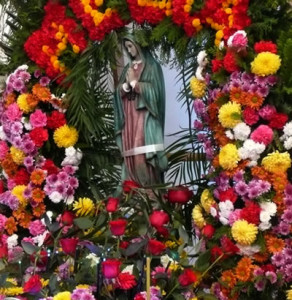Our Lady of Guadalupe, also known as the Virgin of Guadalupe, is Mexico’s beloved patron saint and patroness of the Americas. She is also affectionately known as the Empress of Latin America and is particularly regarded as a protectress of unborn children.
According to the Catholic church, shortly after the conquest of Mexico and the arrival in the territory of Catholic missionaries, who weren’t at all well received by the indigenous populations, a vision of a woman appeared to a man, Juan Diego, at the hill of Tepeyac near Mexico City on December 9, 1531. Speaking to him in his own native language, the woman asked Diego to build a temple on the site of her appearance on the hill. The astounded Juan Diego, recognizing the woman as the mother of Jesus despite her native speech and appearance, reported his vision to the Archbishop of Mexico City, who exhorted the young man to return as ask for a sign that would prove that she was, indeed, the Mother Mary.
 The woman immediately complied and provided Juan Diego with three signs: (1) his uncle was healed of an illness; (2) when asked by the virgin to gather flowers out of season from the top of Tepeyac hill, he found roses not native to that region in full bloom where normally no flowers would grow; and (3) when, following the instructions of the Virgin, he wrapped these blossoms in his crude cactus-fiber cloak to take them to Bishop Zumarraga, the flowers fell to the floor, disclosing an image of the Virgin of Guadalupe imprinted on the lining of Juan Diego’s cloak.
The woman immediately complied and provided Juan Diego with three signs: (1) his uncle was healed of an illness; (2) when asked by the virgin to gather flowers out of season from the top of Tepeyac hill, he found roses not native to that region in full bloom where normally no flowers would grow; and (3) when, following the instructions of the Virgin, he wrapped these blossoms in his crude cactus-fiber cloak to take them to Bishop Zumarraga, the flowers fell to the floor, disclosing an image of the Virgin of Guadalupe imprinted on the lining of Juan Diego’s cloak.
This final miracle occurred on December 12, 1531, only three days after the initial sighting of the Virgin Mary by Juan Diego.
A shrine was built near Tepeyac hill where the sighting took place. Construction was started on a temple at the base of the hill that became the first basilica; this structure was not completed until 1709, and it originally held the image of the Virgin of Guadalupe on its altarpiece.
The new Basílica de Nuestra Señora de Guadalupe, the Roman Catholic church, and Mexican national shrine that now holds the image of the Virgin and the tilma of Juan Diego, was built next to the site of the old basilica between the years of 1974 and 1976. It is an immense circular structure that holds up to 50,000 worshipers; the basilica, known simply as La Villa, receives countless pilgrims and visitors every year, most in the days leading up to and including the Virgin of Guadalupe’s feast day, December 12.
 On that date, December 12, and often for days beforehand, all over Mexico, people in every community form processions through the towns to bring their altars and images of the Virgin of Guadalupe, garlanded in flowers, to the churches for blessing. On the eve of the twelfth, the pilgrims gather at the churches to spend the night in vigil, honoring her with flowers and song, food and dance. Children are dressed up in colorful traditional dress–the young girls as Mary, and the young boys as small Juan Diegos–and photos are taken of them with the image of the virgin against backdrops that can vary from the snow-topped volcanoes of Ixtaccihuatl and Popocatepetl to replicas of the manger scene with the infant baby Jesus and stable animals, particularly donkeys on which the children perch for their photos.
On that date, December 12, and often for days beforehand, all over Mexico, people in every community form processions through the towns to bring their altars and images of the Virgin of Guadalupe, garlanded in flowers, to the churches for blessing. On the eve of the twelfth, the pilgrims gather at the churches to spend the night in vigil, honoring her with flowers and song, food and dance. Children are dressed up in colorful traditional dress–the young girls as Mary, and the young boys as small Juan Diegos–and photos are taken of them with the image of the virgin against backdrops that can vary from the snow-topped volcanoes of Ixtaccihuatl and Popocatepetl to replicas of the manger scene with the infant baby Jesus and stable animals, particularly donkeys on which the children perch for their photos.
[contentblock id=4 img=adsense.png]
References:
- Our Lady of Guadalupe, http://www.catholic.org/saints/saint.php?saint_id=456
- Our Lady of Guadalupe, http://www.sancta.org/
- Wikipedia contributors, “Our Lady of Guadalupe,” Wikipedia, The Free Encyclopedia, http://en.wikipedia.org/w/index.php?title=Our_Lady_of_Guadalupe&oldid=580679028 (accessed November 8, 2013)
- Wikipedia contributors, “Basilica of Our Lady of Guadalupe,” Wikipedia, The Free Encyclopedia, http://en.wikipedia.org/w/index.php?title=Basilica_of_Our_Lady_of_Guadalupe&oldid=574243956 (accessed November 8, 2013).
